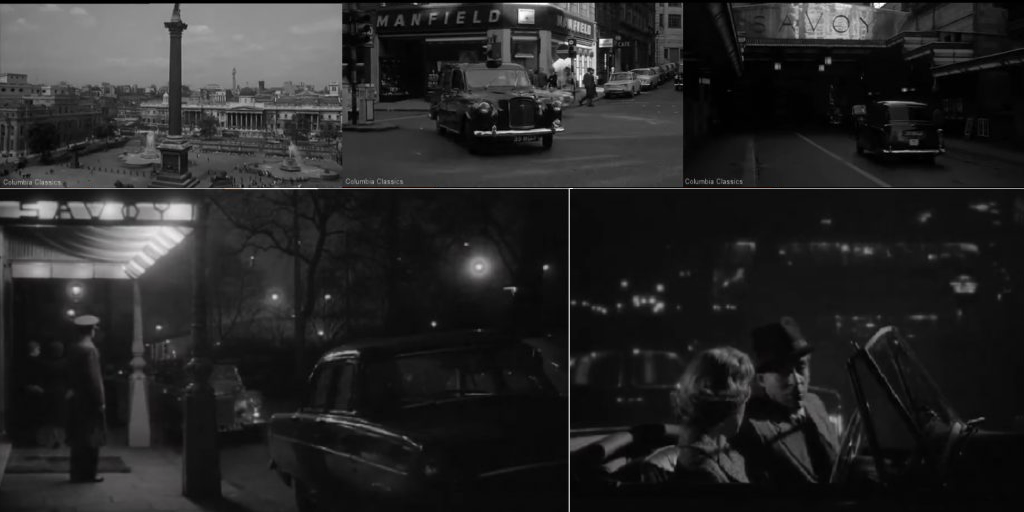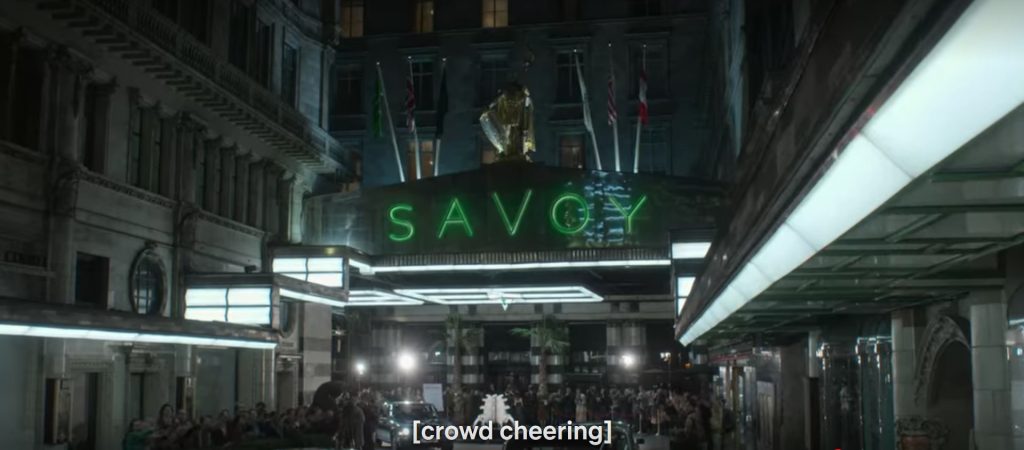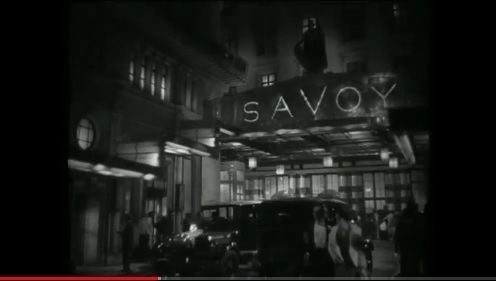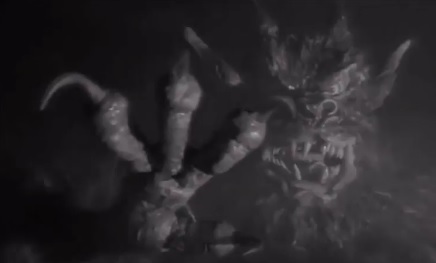The Strand in film: a story of change and eternity
Posted in 20th Century, entertainment, Strandlines, Video and tagged with Curse of the Demon, Disney, film, films, Hollywood, Life at the Top, London, London in the movies, London on film, Men are not Gods, movies, National Treasure, Netflix, Savoy, strand, The Crown, Westminster

Introduction
In my earliest posts on Strandlines, I focused heavily on a bastion of Strand history: The Savoy. Over time I diversified my interests and desired to find the more niche and hidden stories of this great viaduct. Unsurprisingly, however, when I decided to look into depictions of the Strand in film over time the Savoy was ever-present. That iconic entrance has graced more than one film screen over several decades.
This photo is straight out of Netflix’s The Crown, Season 4, episode 9.

Screenshot from Netflix’s The Crown, showing the entrance of the Savoy.
The Crown uses the Savoy as most films and shows do, to indicate that the scene is going to be set in London, and central London at that! The Savoy of course also has connotations of London high life, luxury, and celebrity. Season 4 of the show was released in 2020 and covers the period of 1977 to 1990. Episode 9 in particular appears to be based in 1985 if we link Diana’s rendition of ‘Uptown Girl’ in the show to the event which seems to have really happened.
This period is interesting to keep in mind as we walk down memory lane and see different depictions of the Savoy, Trafalgar Square, and snippets of the Strand in film.
Looking for the Strand: a methodology
I went about my quest to find film on the Strand very simply. Firstly, I looked into films that used central London in their filming locations. Secondly, I used tools provided by IMDB to get list of films based on filming location alone to narrow in on the Strand. Thirdly, I chose a selection of films from across the 20th and 21st century.
- Men are not gods (1936)
- Curse of the demon (1958)
- Life at the top (1965)
- The Crown (set in 1985 – released 2020)
- National Treasure: Book of Secrets (2007)
Now it is fair to say that I did not watch these movies either in their entirety nor for their plot! Instead, I was scouring the films for glimpses of days gone by on the Strand, and evidence of London through the ages caught on camera.
Men are not gods – 1936

1. Trafalgar Square / 2. A shot of the Strand / 3. The now demolished Alhambra Theatre.
I have taken the liberty to leave the video progress bar in these screenshots to allow anyone to be able to find these scenes more easily. Seeing a film of Trafalgar Square from what is now 85 years ago is fascinating. Nelson’s column towers over the scene, an ever-present reminder of London’s unchanging monuments. The camera then pans to the subsequent picture, a street corner with a tube station entrance, various ads, and many shops in sight. Try as I may, I cannot confirm the exact location of this scene though it seems to be on the Strand (if any readers know, please leave your ideas in the comments!).
The third picture is the Alhambra Theatre of Variety. This is cheating a little, I admit. It wasn’t on the Strand. It was on Leicester square and has now been replaced by an Odeon. I felt compelled to include the photo when I discovered that it was kept open just to finish the filming of Men are not Gods and then subsequently destroyed. This may be the last photo of it before its demolition.

The Savoy in 1936.
And, of course, the Savoy made it into the film! In the midst of the hustle and bustle of the famous entrance, Ann Williams talks to Barbara Halford on the success of the latter’s husband, Edmond Davey, who is performing in a rendition of ‘Othello’. Somewhat early in the movie, this scene highlights the start of a troubled period for Williams. As Rod Crawford put it, “[Ann Williams] becomes a fan of Davey and starts to fall for him, much to the jealousy of her boyfriend Tommy […] the characters’ love lives become ever more tangled and a real-life tragedy of Othello looms.”. Even the wealthy residents of the Savoy can’t escape tragedy.
Curse of the Demon – 1958

1. Entrance of the Savoy / 2. Characters sitting in car whilst in front of Savoy.
Now I know what you’re thinking, no this doesn’t look like the Savoy. In fact, it looks like the filmmakers just took any nondescript street, added a fancy ‘Savoy’ sign and a man with a cap in front of the door. Moreover, when the characters are in the car the background is so extraordinarily foggy that they could be parked literally anywhere. This is the eternal struggle of using movies to pinpoint historical locations. ‘Is that it? Is that a set? Could it be the Strand? Or is it just a street more bland?’ These are the questions that torment me with the Curse of the Demon. I will state, as a fact, that it is cited on IMDB as being filmed at the Savoy. Perhaps this is the more discrete canopy on the Embankment side of the building. It shows that even if you don’t show the glorious and oft-shown front entrance of the Savoy, the mere mention of it on screen will make viewers feel as if they were in central London. The foggy shadow of an old routemaster bus behind the characters sells the alleged location even more. Sadly, this movie very briefly makes use of the Savoy and, therefore, of the Strand.
By the way, if anyone here likes cheesy old-style CGI, this is for you. Behold, this ‘terrifying’ monster of late 1950s cinema!

Evil demon / terrifying puppetry!
Life at the top – 1965

1. Trafalgar Square / 2. Exiting the Strand in a black cab / 3. Arriving at the Savoy in style.
Nelson’s column is back to dominate yet another establishing shot in film, to guide the viewer into the next scene. The three stills are back to back scenes in the movie. In a few snaps the viewer is thrown directly into central London. Trafalgar Square, driving on the Strand, and suddenly at the Savoy. In this we see the eternity of London. Trafalgar Square and the Savoy are instantly recognisable. The main difference between then and now are the slightly boxier cars and the taller builds in the skyline behind Trafalgar Square.
National Treasure: Book of Secrets – 2007

1. Savoy entrance / 2. Ben Gates in Buckingham Palace discovering a clue.
This film may seem a little out of place alongside the others. First, it’s modern. Second, the entrance of the Savoy looks no different here than the Crown photo. Third, it is a Disney family movie. While this may all be true, I have to say it’s actually a very good film! National Treasure is an iconic series of movies (sadly, only two were made) and happens to take the adventure to the Strand in the second iteration. As ‘Movie Locations’ put it:
“Nevertheless, it’s off to London with a quick shot of the art-deco frontage of the Savoy Hotel on the Strand to establish the team’s base.” Who can say whether the internal shots are also in the hotel: the magic of cinema establishes our location with that iconic sign and statue.
Conclusion
This wraps up our roller-coaster trip around the Strand through the last century. The Strand has been and remains a key part of central London. As such, it is utilised by directors to situate viewers in this scenery. My title now feels a little misleading. While I did show you the Strand through film, it feels more like a story of perpetuity than change. Despite recently going through multi-million pound refurbishment, the Savoy entrance remains quasi-identical over time, perhaps on purpose. The symbolic “art deco frontage of the Savoy Hotel” and towering Nelson column are comforting sights for the returning guest or viewer. “Welcome back to London” they seem to say. While the Savoy is a business, it does seem to understand its power and place in London’s heritage. Similarly, filmmakers understand the power of symbols like Trafalgar Square and Nelson column in creating an ambiance.
In a time where going into central is an impossible thought, and the idea of being in a mass of people on Trafalgar Square is alien, to the movies you go. On screen you will find all the reminders of the town you love.
